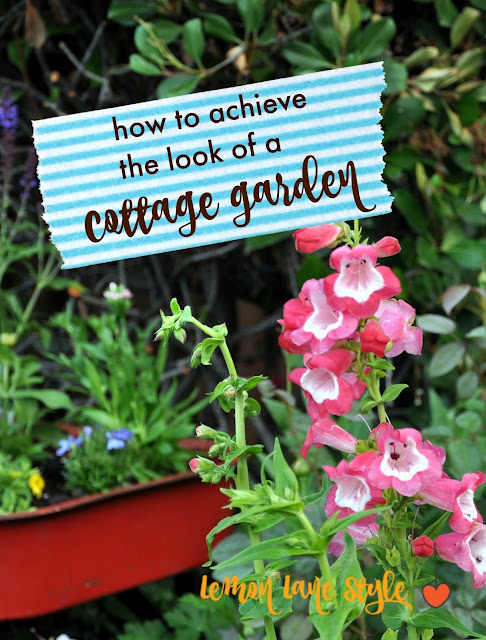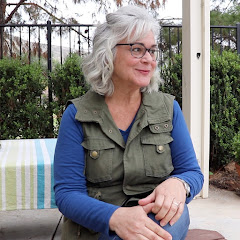I think my neighbors have gotten used to me in my p.j.'s at the crack of dawn, camera in hand. They
barely give me a sideways glance and a little shrug of the shoulders as they go about their business.
I adore this time of the day. It's the most magical time in the garden. The dew is still on the flowers, the harsh afternoon sun hasn't had a chance to scorch my delicate rose blooms and the green of the foliage just seems to pop brighter.
I was bitten by the gardening bug shortly after we bought our first house over 30 years ago and since then have dreamed of planting a true cottage garden overflowing with blooms of all kinds spilling out of its border.
That has proven to be a bit of a challenge in our zone 9 Southern California climate but with a little imagination and a lot of trial and error, I have finally found plants that will tolerate our arid conditions and give the feel of a lush cottage garden.
Here are my suggestions to achieve the look of a cottage garden no matter what your climate.
1. Plant your annual flowers (those flowers that need to be replanted every year) close together. They are relatively inexpensive and go on sale often, I don't pay any attention to what the space requirements are on the tags that come with my annuals, they need to be densely planted. I've come to think of it as natures weed control.
2. Plant at least three of each type of flower in a cluster together. It can be tempting to scatter them for a more colorful look or even plant them in straight rows but I always try to think of their seeds being spread by birds. They would drop them a few at a time all over the garden, not perfectly spaced.
3. Vary the heights. Sometimes that can mean a taller plant ends up in the front. I know this goes against classic garden design which calls for taller plants toward the rear but again, I think about nature scattering plants willy nilly. Some tall plants might end up in front. (For orders sake, most of my taller varieties are toward the center or rear of my garden but one or two always manage to sneak to the front for a more natural look.)
4. Use perennials as much as possible. (Perennials are those plants that die back every year and come back the following year.) They take a little longer to get established and are a bit more pricey but in the end, because they come back every season, they give you more bang for your buck.
5. Limit your garden to three or four colors and spread them liberally throughout the bed in waves of color. Again, a true cottage garden is a hodge podge of flowers crowded into a small area but limiting the colors to just a few will help to keep the chaos under control.
6. Use green bushes to help fill in the space and provide a place for your eyes to rest. This will partially be achieved through your choice of perennials which normally have a specific blooming period and then remain as just foliage for the rest of the gardening season but adding a few evergreen bushes will give the garden a more lush look of abundance.
7. Use quality amendments in your soil. As in all gardening the key is good garden dirt. I add fresh compost to mine every time I put in new flowers, this helps to ensure a good root system and healthier plants over all.
8. Make friends with the folks at your local garden center. They will prove to invaluable as you select flowers that do well in your climate and growing zone.
I must admit to being a six pack girl (plants not beer) and nothing thrills me more than a trunk full of beauties waiting to be put into the ground. My husband says I buy them faster than I can plant them. He's right, I just can't help myself. They just call my name as I walk on by!
I have so many favorites...roses, foxglove, delphiniums, daisies, dianthus, nastartium, sweet alyssum, lobelia, geraniums to name but a few. If it's blooming then it's my favorite!
As a result my gardens are a hodge podge of what works in my zone 9 climate and what ever catches my fancy at the garden center. Trust me I have had many plants that just didn't do well in my flower beds and I have learned to be ruthless in the amount of time I give them to flourish but the successes far out number the failures and I will take my achievements in the garden, as in life, where ever I can get them.
xo, Patty
p.s. If you want to know what I do to enrich my soil you can read my post how I prepare the soil for spring planting.
I'll be providing a list of my favorite cottage flowers by season and region exclusively in next Monday's newsletter. Be sure to sign up below to receive it in your inbox if you haven't already.













Beautiful, wonderful ideas! Sharing later today. :)
ReplyDeletePatty, You garden is looking so good. Love all the pretty colors. It's been too cold for us here in central Indiana to play in the gardens. I am getting a work out carrying my flats of pansies here and there to keep them alive. LOL. Blessings, xoxo, Susie
ReplyDeleteI've always admired your gardening skills. Thanks for all the ideas. I love cottage gardens, but have a hard time achieving the look. Hubby is more of a row guy, but I'll try to sneak more random plantings in.
ReplyDeleteI am soooo jealous right now! I just can't wait until it's warm enough to plant, I miss my garden so much! Your garden is gorgeous, I agree with your ideas, I always plant my annuals closer together so they really cover the ground. Thanks for sharing your garden with all of us who are still waiting for Spring!
ReplyDeleteYou should start a six pack club for us garden girls lol.
ReplyDeleteYou have such beautiful flowers. I can't wait until our flower season starts. I am in Zone 5. Nancy
ReplyDeleteYour garden is just beautiful. Cottage gardens are my favorite garden style and your tips for achieving one are great advice.
ReplyDeleteIn answer to the question you asked on my blog, yes... I would be flattered to be featured.
Thanks. Kim